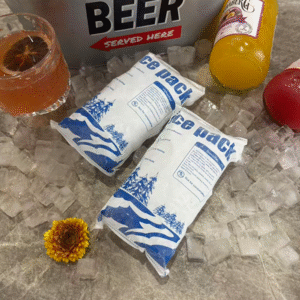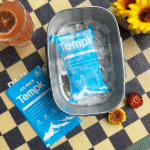مقدمة
في لوجستيات السلسلة الباردة, حبيبات الثلج الجاف و حزم الثلج الجاف أصبحت أدوات التبريد الأساسية للحفاظ على سلامة المنتج من المستودع إلى الوجهة. سواء كنت تقوم بشحن اللقاحات, المأكولات البحرية, أو العينات المخبرية, اختيار شكل الثلج الجاف المناسب لا يحدد استقرار درجة الحرارة فحسب، بل يحدد أيضًا كفاءتك التشغيلية والتحكم في التكاليف.
في هذا 2025 مرشد, ستتعلم كيفية اختيار وتطبيق حلول الثلج الجاف التي تتوافق مع أهدافك اللوجستية, المتطلبات التنظيمية, ومعايير الاستدامة.
-
ال الاختلافات الرئيسية بين كريات الثلج الجاف وحزم الثلج الجاف
-
حالات الاستخدام الأفضل عبر الصيدلانية, طعام, والقطاعات اللوجستية
-
التخزين والسلامة ممارسات التعامل مع الثلج الجاف
-
2025 الابتكارات تحسين استدامة سلسلة التبريد
-
كيف تعظيم أداء التبريد مع تقليل النفايات
ما هي كريات الثلج الجاف وكيف يتم استخدامها في الخدمات اللوجستية لسلسلة التبريد?
حبيبات الثلج الجاف صغيرة الحجم, قطع أسطوانية من ثاني أكسيد الكربون الصلب (co₂) مصممة للسرعة, التبريد المباشر. ولأنها تتسامى - وتتحول مباشرة من الحالة الصلبة إلى الغازية - فإنها لا تترك أي بقايا سائلة, مما يجعلها مثالية للسلع الحساسة لدرجة الحرارة.
يتم استخدامها على نطاق واسع في الصناعات التي يكون فيها الحفاظ على درجات حرارة منخفضة للغاية أمرًا بالغ الأهمية, مشتمل الشحن الصيدلاني, عينات التكنولوجيا الحيوية, و نقل المواد الغذائية المجمدة.
كيف تعمل كريات الثلج الجاف عمليا?
تمتص كريات الثلج الجاف الطاقة الحرارية بسرعة, إنتاج تبريد مكثف عند -78.5 درجة مئوية (-109° f). ويضمن هذا الانخفاض السريع في درجة الحرارة بقاء المنتجات مجمدة أثناء النقل لمسافات طويلة. تسمح مساحة السطح الصغيرة للكريات بالتوزيع المتساوي داخل الصناديق المعزولة أو حاويات الشحن, عرض تغطية حرارية متسقة.
نظرة عامة مقارنة: كريات الثلج الجاف مقابل. خيارات التبريد الأخرى
| طريقة التبريد | نطاق درجة الحرارة | مدة | التطبيق المثالي | فائدة العالم الحقيقي |
|---|---|---|---|---|
| كريات الثلج الجاف | -78.5درجة مئوية | 24-48 ساعة | الشحن فائق البرودة | لا بقايا سائلة, التحكم في درجة الحرارة الدقيقة |
| حزم الثلج الجاف | -40درجة مئوية إلى -60 درجة مئوية | 36-72 ساعة | التبريد على المدى المتوسط | أبطأ التسامي, قابل لإعادة الاستخدام, وضع مرن |
| حزم هلام | 0درجة مئوية إلى -20 درجة مئوية | 12-24 ساعة | نقل المواد الغذائية القابلة للتلف | صديقة للميزانية, قابل لإعادة الاستخدام |
| مواد تغيير المرحلة (بي سي إم) | قابل للتخصيص | 24-96 ساعة | الأدوية الحيوية أو مجموعات التشخيص | نطاقات درجة حرارة مستقرة |
نصائح عملية لاستخدام كريات الثلج الجاف
-
للأدوية: استخدم الكريات عالية الكثافة في شركات الشحن المعزولة بالفراغ لتحقيق أقصى قدر من الكفاءة.
-
للطعام: ضع الكريات بالتساوي أسفل المنتجات وحولها لتجنب الذوبان الجزئي.
-
للخدمات اللوجستية: قم بدمج الكريات مع المواد المتغيرة الطور للشحن الممتد متعدد المناطق.
مثال: شحنة لقاح تتطلب ثباتًا عند -70 درجة مئوية 48 ساعات من تحقيق أفضل النتائج باستخدام 5 كجم من كريات الثلج الجاف مقاس 3 مم في حاوية EPS عالية الأداء, تقليل مخاطر التلف عن طريق 40%.
متى يجب عليك استخدام عبوات الثلج الجاف بدلاً من الكريات؟?
عبوات الثلج الجاف عبارة عن حاويات محكمة الغلق مملوءة بثلج ثاني أكسيد الكربون المضغوط أو ملاط ثاني أكسيد الكربون المجمد. لقد تم تصميمها لتوفير مدة تبريد أطول مع إطلاق بخار أقل, مما يجعلها مثالية للشحنات متوسطة الحرارة أو الأنظمة اللوجستية القابلة لإعادة الاستخدام.
مزايا عبوات الثلج الجاف في 2025 عمليات سلسلة التبريد
-
مدة التبريد الممتدة – ما يصل إلى 72 ساعات من درجة الحرارة المستقرة.
-
لا يوجد خطر الاتصال المباشر – أكثر أمانا للعاملين الذين يتعاملون مع الشحنات الكبيرة.
-
تصميم قابل لإعادة الاستخدام - يقلل من نفايات التغليف والتكاليف التشغيلية.
-
أحجام قابلة للتخصيص – تركيب الصناديق المعزولة, الصناديق, والمنصات بسهولة.
الاختلافات الرئيسية بين كريات الثلج الجاف والحزم
| ميزة | كريات الثلج الجاف | حزم الثلج الجاف | ماذا يعني لك |
|---|---|---|---|
| سرعة التبريد | سريع جدًا | تدريجي | اختر الكريات للتجميد السريع; عبوات للتبريد المتحكم فيه |
| إعادة الاستخدام | استخدام واحد | متعدد الاستخدام | العبوات أفضل للشحنات المتكررة |
| التعامل | يتطلب معدات الوقاية الشخصية | أكثر أمانًا في التعامل معها | العبوات تقلل من التعرض لثاني أكسيد الكربون |
| يكلف | أقل لكل كيلوغرام | أعلى لكل وحدة | يعتمد على وتيرة الشحن |
انسايت القضية: قام أحد مصدري المأكولات البحرية باستبدال الشحن المعتمد على الحبيبات بأكياس ثلج جاف قابلة لإعادة الاستخدام, قطع نفايات التغليف عن طريق 60% مع الحفاظ على اتساق -40 درجة مئوية 72 ساعات.
كيفية التعامل مع الثلج الجاف وتخزينه بأمان في عمليات سلسلة التبريد لديك
يوفر الثلج الجاف فوائد حرارية كبيرة، ولكنه يتطلب التعامل المناسب. يمكن أن يؤدي التخزين أو التهوية غير الآمنة إلى تراكم الضغط أو مخاطر التعرض لثاني أكسيد الكربون.
إرشادات التخزين
-
تخزين الثلج الجاف في المناطق تهوية, أبدا في حاويات محكمة الإغلاق.
-
احتفظ بغرف التخزين بينهما -80درجة مئوية و-20 درجة مئوية للاحتفاظ الأمثل.
-
تجنب ملامسة الجلد مباشرة; استخدم دائما قفازات معزولة.
-
تدوير المخزون باستخدام أولا في, أولًا (يصرف أولاً) نظام.
نصائح النقل
-
يستخدم حاويات معزولة بفتحات تهوية لمنع تراكم ثاني أكسيد الكربون.
-
تتبع درجات الحرارة الداخلية باستخدام مسجلات البيانات الرقمية أو أجهزة استشعار إنترنت الأشياء.
-
تدريب الموظفين على إجراءات الطوارئ الخاصة بتسرب ثاني أكسيد الكربون أو حالات قضمة الصقيع.
| نوع المخاطرة | سبب | وقاية | التأثير عليك |
|---|---|---|---|
| تراكم CO₂ | تهوية سيئة | قم بتركيب مراوح العادم | يمنع مخاطر العمال |
| ذوبان المنتج | العزل غير السليم | استخدم EPS أو الألواح المفرغة | يقلل من فقدان المنتج |
| قضمة الصقيع | الاتصال المباشر | استخدام القفازات المعزولة | يضمن سلامة العمال |
ملاحظة السلامة: في 2025, تعتمد معظم المرافق اللوجستية أجهزة استشعار ذكية لثاني أكسيد الكربون مدمجة مع التحكم في التهوية بالذكاء الاصطناعي للحفاظ على الامتثال لمعايير ISO 23412 معايير سلامة سلسلة التبريد.
كيفية تعظيم كفاءة التبريد وخفض التكاليف في 2025
يظل الثلج الجاف حلاً فعالاً من حيث التكلفة ومستدامًا عند تطبيقه بشكل استراتيجي. للحد من كليهما نفايات الطاقة و تكلفة المواد, تقوم الشركات بدمج أنظمة مراقبة درجة الحرارة الذكية والتبريد الهجين.
استراتيجيات التحسين
-
استخدم التنسيق الصحيح: الكريات للتجميد السريع; عبوات للتبريد المستمر.
-
التعبئة والتغليف قبل التبريد: يقلل من معدل التسامي بنسبة تصل إلى 15%.
-
تتحد مع بطانات معزولة: يطيل مدة التبريد بنسبة 20-30%.
-
مراقبة فقدان التسامي: استخدم أجهزة التتبع الذكية لتحسين دورات التجديد.
بيانات الصناعة (2025): أبلغت الشركات التي تطبق أنظمة هجينة لتعبئة الثلج الجاف عن أ 25% تحسن في اتساق درجة الحرارة و 18% تخفيض تكاليف مواد التبريد.
زاوية الاستدامة
يحتضن لاعبو سلسلة التبريد الحديثة أنظمة استعادة ثاني أكسيد الكربون, السماح بإنتاج الثلج الجاف من الانبعاثات المحتجزة، مما يدعم أهداف الاقتصاد الدائري وحياد الكربون.
2025 الاتجاهات في تكنولوجيا التبريد بالثلج الجاف
يتطور قطاع سلسلة التبريد بسرعة, مع تكنولوجيا الثلج الجاف في طليعة الابتكار اللوجستي المستدام.
التطورات الرئيسية
-
الكريات الآلية: إنتاج حجم بيليه ثابت, تقليل النفايات.
-
صفائح الثلج الجاف القابلة لإعادة الاستخدام: اجمع بين مرونة العبوات وقوة تبريد الحبيبات.
-
أجهزة استشعار المراقبة الذكية: تتبع مستويات ثاني أكسيد الكربون ومعدلات التسامي في الوقت الفعلي.
-
تكامل التغليف الحيوي: تقليل المواد البلاستيكية ذات الاستخدام الواحد في الصناديق الحرارية.
رؤى الأسواق الناشئة
-
فارما سلسلة التبريد: تزايد في 7.3% CAGR, مدفوعة بشحنات الأدوية البيولوجية.
-
التجارة الإلكترونية تسليم الأغذية: زيادة 35% في 2025, تتطلب حلول تبريد متوسطة المدى.
-
اللوجستية المستدامة: زيادة 60% من مقدمي الخدمات يعتمدون الآن أنظمة العبوات القابلة لإعادة الاستخدام.
الأسئلة المتداولة
س 1: ما هي مدة بقاء حبيبات الثلج الجاف في مرحلة النقل؟?
عادة, 24-48 ساعة, اعتمادا على نوعية العزل ودرجة الحرارة الخارجية.
Q2: هل يمكن أن تحل عبوات الثلج الجاف محل عبوات الثلج العادية?
نعم, خاصة بالنسبة للشحنات التي تتطلب درجات حرارة أقل من -40 درجة مئوية. أنها توفر أداء أطول ولا بقايا الماء.
س 3: هل الثلج الجاف آمن للنقل الجوي؟?
نعم, ولكن يجب الالتزام بها لوائح الاتحاد الدولي للنقل الجوي بشأن البضائع الخطرة (قسم 5.5.3), تتطلب وضع العلامات والحاويات المهواة.
س 4: كيف أعرف مقدار الثلج الجاف الذي يجب استخدامه?
كقاعدة عامة, تخصيص 5– 10 كجم من الثلج الجاف لكل شحنة على مدار 24 ساعة لكل 100 لتر من الحجم المعزول.
س 5: ما هي أفضل البدائل الصديقة للبيئة للثلج الجاف التقليدي؟?
كريات Bio-CO₂ وحزم تغيير الطور القابلة لإعادة الاستخدام مع أغلفة خارجية قابلة لإعادة التدوير.
ملخص وتوصيات
تخدم كل من كريات الثلج الجاف وعبوات الثلج الجاف أدوارًا مميزة في لوجستيات سلسلة التبريد.
الكريات تتفوق بسرعة, تطبيقات شديدة البرودة, بينما تقدم العبوات ثباتًا, تبريد قابل لإعادة الاستخدام لفترات طويلة. يعتمد الاختيار الأمثل على حساسية منتجك, مدة النقل, وأهداف الاستدامة.
الوجبات الرئيسية
-
يستخدم حبيبات الثلج الجاف للعمليات الصيدلانية أو التجميد السريع.
-
يختار حزم الثلج الجاف قابلة لإعادة الاستخدام, تسليمات متوسطة الحرارة.
-
تحديد الأولويات التتبع الذكي والتبريد الهجين لكفاءة التكلفة.
-
دمج أنظمة استعادة ثاني أكسيد الكربون لعمليات أكثر خضرة.
الخطوات التالية
-
قم بمراجعة إعداد سلسلة التبريد الخاصة بك – تحديد المراحل الحرجة لدرجة الحرارة.
-
حدد تنسيق الجليد الصحيح على أساس المدة والحساسية.
-
الترقية إلى الحاويات الذكية مع المراقبة الحرارية الرقمية.
-
شريك مع الموردين المعتمدين للحصول على جودة ثلج جاف متسقة.
نصيحة العمل: لاحتياجات الشحن المعقدة, اختبر كلاً من كريات وعبوات الثلج الجاف في ظل ظروف خاضعة للرقابة لتحديد أي منها يقدم أفضل نسبة تكلفة إلى درجة حرارة لعمليتك.
حول Tempk
في Tempk, نحن متخصصون في حلول التعبئة والتغليف المتقدمة لسلسلة التبريد والتحكم في درجة الحرارة التي تحافظ على سلامة منتجاتك من المنشأ إلى الوجهة.
تغطي خبرتنا تكنولوجيا الثلج الجاف, الشاحنين المعزولون, و مراقبة درجة الحرارة على أساس إنترنت الأشياء- موثوق به من قبل الأدوية, طعام, وقادة الخدمات اللوجستية في جميع أنحاء العالم.
نحن نبتكر باستمرار مع مواد صديقة للبيئة و طرق إنتاج فعالة لثاني أكسيد الكربون لمساعدة عملك على تحقيق أهداف الأداء والاستدامة.
دعوة إلى العمل:
تريد تحسين أنظمة التبريد الخاصة بك ل 2025? اتصل بخبرائنا للحصول على مشورة مخصصة وتحليل مجاني لأداء سلسلة التبريد.
























